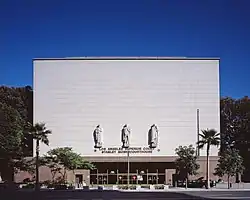 North Hill Street in Chinatown | |
| Length | 4.8 mi (7.7 km) |
|---|---|
| Location | Los Angeles, California, U.S. |
| Nearest metro station | |
| Southern end | Martin Luther King, Jr. Boulevard, South Figueroa Corridor |
| Northern end | Arroyo Seco Parkway, Chinatown |

Hill Street is a major north–south thoroughfare in Los Angeles, measuring 4.8 miles (7.7 km) in length. It starts on Martin Luther King, Jr. Boulevard near the campus of USC, and passes north through Downtown Los Angeles, past such landmarks as Pershing Square, the Subway Terminal Building, Angels Flight,[n 1] Fort Moore and Chinatown. Hill Street merges with the Arroyo Seco Parkway near Dodger Stadium.
History
.jpg.webp)
Hill Street was originally laid out in 1849 by Edward Ord. At that time, the street ended in the north at 1st Street, where the foot of Fort Hill sat. The stretch of modern Hill Street north of the old hill was originally named Calle del Toro (Bull Street),[1][2][3] was renamed Castelar in 1874,[4] and finally renamed North Hill in 1960.[5]
Transportation
The Metro B Line and Metro D Line run underneath Hill Street between 1st and 4th Streets and operate the Civic Center and Pershing Square stations along the way. Metro Local lines 2, 4, 10, 28, 81, and 94 run along the surface. The Angels Flight funicular climbs west up Bunker Hill from Hill between 3rd and 4th streets.
Education
Number of schools are located at or nearby Hill Street. They include Cathedral High School, Castelar Elementary School, High School for the Visual and Performing Arts, Evans Community Adult School, the William Jefferson Clinton Middle School, Orthopaedic Hospital Medical Magnet High School, Santee Education Complex, and Los Angeles Trade-Tech College.
Los Angeles Public Library has the Chinatown branch located at Hill and Ord Streets.
Landmarks
- North of US-101 freeway

- Chinatown Branch Library, Hill and Ord streets
- Ramón C. Cortines School of Visual and Performing Arts (back side)
- Fort Moore Pioneer Memorial (451 N. Hill)
- Site of Los Angeles High School building (1891, razed)
- Civic Center

- Cathedral of Our Lady of the Angels (2002, Rafael Moneo, Modern architecture with deconstructivist elements)
- Kenneth Hahn Hall of Administration (1960, Stanton, Stockwell, Williams and Wilson, Late Moderne architecture)
- Los Angeles County Hall of Records (1962)
- Grand Park
- Stanley Mosk Courthouse (1958, Stanton, Stockwell, Williams and Wilson, Late Moderne architecture)
- United States Courthouse (First Street, Los Angeles), opened 2016, built on the site of the demolished First Junipero Serra State Office Building (Stanton & Stockwell, 1960)
- Third to Fourth streets
- Fourth to Fifth streets
.jpg.webp)
- Former Broadway Department Store (back side), now Junipero Serra State Office Building (#2)
- Subway Terminal Building , now Metro 417 residential
- Title Guarantee and Trust Company Building (1930)
Fifth to Sixth streets:
- Pershing Square
- Pershing Square station
- Site of Paramount Theatre (movie palace), now International Jewelry Center
- Sixth to Seventh streets
- Consolidated Reatly Bldg./California Jewelry Mart (1908/1935)
- Sun Realty Bldg./Los Angeles Jewelry Center (1931)
- Harris & Frank Bldg./Wholesale Jewelry Exchange (1925)
- Western Jewelry Mart
- William Fox Bldg. (Fox Jewelry Plaza) (1932)
- former Warner Bros. (a.k.a. Pantages, Warren) Theatre (movie palace, 1920), now Jewelry Theatre Center
- Bullock's department store buildings (back entrance), now St. Vincent Jewelry Center
- Seventh to Eighth streets
- Foreman & Clark department store building (site, 1928)
- Garfield Building (1930)
- Union Bank and Trust Company building (1922), now Union Lofts
- Eighth to Ninth streets
- Site of the RKO Hillstreet Theatre (1922–1963), now 820 Olive (residential)
- Coast Federal Savings Building (1926)
- Ninth St. to Olympic Blvd.
- May Company Garage - 1926 - one of the Nation's first parking structures (Los Angeles Historic-Cultural Monument No. 1001)
- South Park by Windsor Apts.
- South of Olympic Blvd.
- The Mayan
- Site of Belasco Theatre
- White Log Coffee Shop
- John Adams Middle School (151 W. 30th St.)
Notes
- ↑ A 2001 civic ceremony held in honor of mishap casualty Leon Praport at the Hill Street entrance to Angels Flight, where conductor David Woodard premiered "An Elegy for Two Angels," necessitated a midday street cordon.
References
- ↑ Cameron, Tom (September 1, 1953). "What's In A Street Name?". Los Angeles Times. p. A5. Archived from the original on November 25, 2015.
Another is called Calle del Toro, which was changed to Castelar.
Alternate Link via ProQuest. - ↑ "The Street Scene". Los Angeles Times. August 31, 1980. p. y36. Archived from the original on November 25, 2015. Alternate Link via ProQuest.
- ↑ "Early Map is Odd Document: Explains Derivation of Names of Streets Shows Reason Why Main and Spring Join Survey is Made Before City Incorporated". Los Angeles Times. November 30, 1924. p. E3. Archived from the original on November 25, 2015. Alternate Link via ProQuest.
- ↑ "Common Council". Los Angeles Herald. Vol. 1, no. 114. February 14, 1874. p. 3 – via California Digital Newspaper Collection.
A petition was received from a number of property owners, requesting that Grasshopper street be changed to Union Avenue, Bull street to Castelar, and Wasp street to Yale street. The petition was favorably received and a special committee, in conjunction with the City Attorney, was appointed to draft an ordinance to comply with the request.
- ↑ "Castelar St. Now Is Hill". Los Angeles Times. March 25, 1960. p. 29. Archived from the original on November 25, 2015.
Castelar St., running past New Chinatown between Sunset Blvd. and Bernard St., was taken off the map yesterday by the City Council. The name change had the backing of the Board of Works, New Chinatown Chamber of Commerce and Castelar St. residents. The Historical Society of Southern California offered no objection, saying the name Castelar had little historical significance.
Alternate Link via ProQuest.